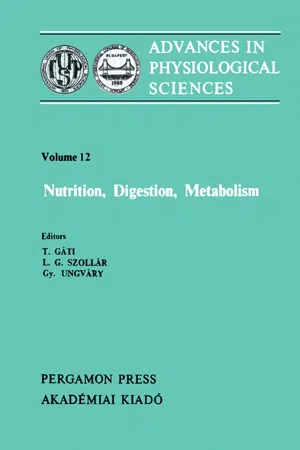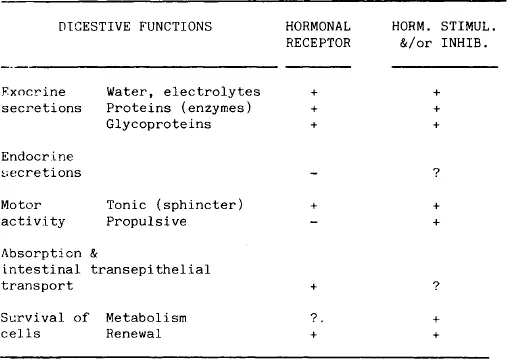Table II
CRITERIA FOR RECEPTOR STUDIES
| CRITERIA | REQUIREMENTS |
| 1. Homogeneity of the tissue | Isolated cells Enrichment in one cell type Group of cells with a predominant functional activity |
| 2. Specificity of the binding | Radiolabeled hormones with full biological activity Distinction of various types of sites |
| 3. Intracellular messenger activities | cAMP, cGMP, Ca++, protein kinases |
| 4. Functional responses | Specific and/or relevant for organ physiology |
| 5. Competence within the E.Ds. | obtained from 2., 3., 4. |
Isolated Cell Models
They are largely used as intact and living cells derived from various tissues: stomach fundic mucosa with isolation and separation of parietal and non-parietal cells (8, 13); pancreas acinar cells (3); enterocytes (5). Two of the four above criteria may be parallely obtained, i.e. homogeneity of the tissue and specificity of hormone binding; this specificity, not only derives from the tissue homogeneity but also from the presence of the hormone in its native condition, at a precisely known concentration and without interferences of blood supply and/or nervous influx.
On the other hand, assessing relevant activity(ies) of the cell is often difficult due to the decrease and/or to the change in cell activity when separated from normal tissue structures. Furthermore, often the biological signal is not easily characterized in the survival medium where the cells are tested: for instance acid secretion of the parietal cells can be only indirectly evidenced with the trapping of the C labelled weak basis aminopyrine. Pancreatic acinar cell activity is easier to assess by measuring amylase output. O2 consumption (12) is a usefull tool when the specific functions of the cells have close relation with oxydative metabolism. On the whole, the sensitivity of these models is poor (table III).
Table III
ISOLATED CELL MODELS
| ADVANTAGES | DISADVANTAGES |
| Receptors: direct access | Loss of cell polarisation |
| Stimulant: not metabolised local concentration precisely known | Weak Marginal Abnormal Biol. response |
| No interference from: blood supply nervous influx | Inadequacy to organ physiolog |
Membrane models, such as vesicles, cannot be studied by reference to a specific biological response. Measurement of intracellular messenger activities is usually considered as representative of the biological response, but cannot ascertain the physiological interest of the results. Even if some kinds of biological activity are characterized (e.g. change in intravesicular pH or ion transports), their relevance to physiology may remain disputable.
From tissue or cells one can obtain rough homogenates and further purifications increase the specificity of binding and/or messenger studies. However, the homogeneity of the original material remains the most determinant factor for specific hormone receptor studies.
Isolated cells models have evidenced a number of cell-hormone relationships that could be interpreted in respect to receptor:
- affinity of one hormone for one cell type, considering the presence of one or multiple receptor type(s) (e.g. high and low affinity);
- variety of hormone receptors for one cell type; site to site interactions;
- determination of the number of sites per cell;
- ability for one receptor-type to recognize various molecular forms of one hormone or various hormones;
- internalization of receptors suggesting intracellular hormone transport.
Isolated cell models have been particularly fruitful in the following studies:
- parietal cell receptors (7): binding and stimula...

